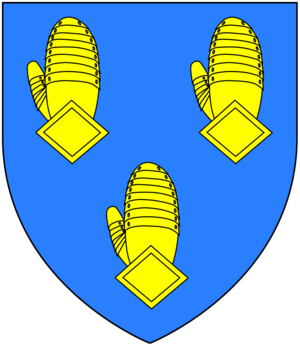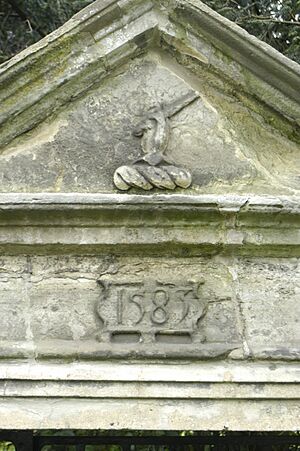Thomas Fane (died 1589) facts for kids
Thomas Fane (around 1538–1589) was an important person from Kent, England. He lived at Badsell Manor in Tudeley and also at Mereworth Castle. He held the important job of Sheriff of Kent. It's easy to mix him up with his younger brother, also named Thomas Fane, who was a Member of Parliament for Dover.
Who Was Thomas Fane?
Thomas Fane was born around 1538 at Badsell. He was the older son of George Fane (who died in 1572). His father, George, was also the Sheriff of Kent in 1557 and 1558. Thomas's mother was Joan Waller, who passed away in 1545. His family had lived in Kent for a long time.
His Family History
The Fane family has an interesting story about their beginnings. Some say they came from a brave Welsh knight named Sir John Fane. He was known for capturing the King of France at a big battle in 1356 called the Battle of Poitiers. Because of this brave act, his family was given a special golden glove (a gauntlet) as part of their family crest. They also have three golden gauntlets on their family shield.
However, some historians have different ideas about the very first Fane family member. They believe the earliest known ancestor was "Henry a Vane" from Tonbridge, Kent, who lived in the 1400s. There are different opinions on how far back the family's history can be proven.
What He Did
Thomas Fane went to Maidstone Grammar School. He was a strong Protestant. In 1554, he was involved in a rebellion known as Wyatt's rebellion. Because of this, he was found guilty of treason, which meant going against the queen. He was sentenced to death and spent four months in the Tower of London.
But Queen Mary pardoned him because he was young. He promised to be loyal to her. After this, Thomas Fane continued to serve the crown. He became the High Sheriff of Kent in 1572. In 1573, he was made a knight for his good service to the queen. This meant he was given the title "Sir."
A special monument to Sir Thomas Fane can still be seen today in St Lawrence's Church in Mereworth, Kent.
His Marriages and Children
Sir Thomas Fane was married two times:
- His first wife was Elizabeth Culpepper. She sadly passed away during childbirth.
- His second wife was Mary Neville, Baroness le Despencer. Mary was very important because she was the only child and heir of a powerful nobleman, Henry Nevill. This meant she inherited a lot of land and wealth, making her one of the richest landowners in England.
Mary Neville also inherited important noble titles from her father, including Baron le Despenser and Baron Bergavenny. One of these titles, the Barony of le Despenser, was officially brought back for her in 1604, making her the 3rd Baroness le Despenser. She also inherited her father's estates, including Mereworth Castle.
Their son was later given the title Earl of Westmorland by King James I. This title had previously been taken away from Mary Neville's cousin, Charles Neville, in 1571 because he took part in a rebellion called the Rising of the North.
Thomas Fane and Mary Neville had children, including:
- Francis Fane, 1st Earl of Westmorland: He was their oldest son and inherited his mother's titles.
- George Fane: He lived in Burston, Kent.



